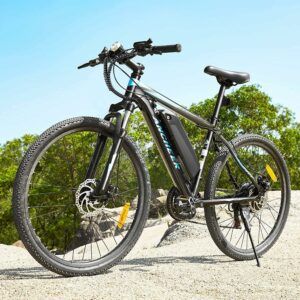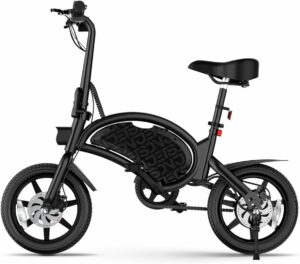 Today, I’m excited to share my insights on the best eBikes under $1000 for beginners. Affordability doesn’t mean compromise – there are plenty of great options that offer reliable performance and features to get you started on your eBike adventure.
Today, I’m excited to share my insights on the best eBikes under $1000 for beginners. Affordability doesn’t mean compromise – there are plenty of great options that offer reliable performance and features to get you started on your eBike adventure.
Understanding eBike Basics
An eBike is essentially a bicycle equipped with an electric motor and battery that provides assistance as you pedal. This pedal-assist feature makes cycling more accessible to riders of all fitness levels and can improve your daily commute or weekend adventures.
Motor Types
Most eBikes in this price range use hub motors, typically located in the rear wheel. While not as sophisticated as mid-drive motors found in pricier models, hub motors offer reliable performance and are easier to maintain. They provide a smooth, consistent ride that’s perfect for beginners.
Battery Range
Battery range is a crucial factor to consider when choosing an eBike. In the sub-$1000 category, you can expect a range of 20-40 miles on a single charge.
However, this can vary significantly based on factors like terrain, rider weight, and the level of assistance you’re using.
To maximize your range:
- Start with a full charge
- Use lower assistance levels when possible
- Pedal efficiently
- Plan your routes to avoid steep hills
Speed Limitations
To comply with regulations, most eBikes in this category are limited to a top speed of 20 mph. This puts them in the Class 1 or Class 2 eBike category, which means they’re legal to ride in most bike lanes and paths without requiring a license.
Top eBike Models Under $1000
After extensive research and hands-on testing, here are my top picks for the best eBikes under $1000:
1. Ancheer 26″ Electric Mountain Bike
 The Ancheer 26″ Electric Mountain Bike offers versatility for both urban commutes and light trail riding. It’s key features include:
The Ancheer 26″ Electric Mountain Bike offers versatility for both urban commutes and light trail riding. It’s key features include:
- 250W motor
- 21-speed Shimano gears
- Removable 36V 8Ah battery
- Range of 15-30 miles
I found the Ancheer to be a solid all-rounder, capable of handling various terrains with ease. The removable battery is a nice touch, allowing for easy charging and the option to purchase a spare for extended rides.
2. Swagtron EB-5 Pro City Folding eBike
For those short on storage space, the Swagtron EB-5 Pro is a game-changer. It’s compact folding design makes it ideal for apartment dwellers or commuters who need to mix their eBike ride with public transportation.
Key features include:
- 250W motor
- 36V battery
- Range of up to 15.5 miles
- Folding frame and handlebars
During my test rides, I was impressed by how quickly and easily the EB-5 Pro folds down. While the range is shorter than some other models, it’s more than sufficient for most urban commutes.
3. Ecotric 20″ Fat Tire Folding Electric Bike
 The Ecotric Fat Tire eBike is designed to tackle varied terrain with confidence. It’s wide tires provide stability on sand, snow, or gravel, making it a versatile choice for adventurous riders.
The Ecotric Fat Tire eBike is designed to tackle varied terrain with confidence. It’s wide tires provide stability on sand, snow, or gravel, making it a versatile choice for adventurous riders.
Key features include:
- 500W motor
- 36V 12Ah battery
- Range of 18-23 miles
- Fat tires for improved stability
I found the Ecotric to be a blast to ride on both paved roads and light trails. The fat tires absorb bumps well, providing a comfortable ride even on rougher surfaces.
4. Nakto 26″ City Electric Bicycle
 The Nakto City Electric Bicycle is perfect for casual riders or those with limited mobility. It’s step-through frame and upright riding position offer comfort and ease of use.
The Nakto City Electric Bicycle is perfect for casual riders or those with limited mobility. It’s step-through frame and upright riding position offer comfort and ease of use.
Key features include:
- 250W motor
- 36V 10Ah battery
- Range of 22-28 miles
- Step-through frame
During my test rides, I appreciated the Nakto’s comfortable riding position and smooth acceleration. The included rear rack is a nice bonus for carrying groceries or other small items.
5. Jetson Bolt Pro Folding Electric Bike
 The Jetson Bolt Pro is an ultra-compact eBike perfect for urban environments. It’s small size and light weight make it incredibly portable.
The Jetson Bolt Pro is an ultra-compact eBike perfect for urban environments. It’s small size and light weight make it incredibly portable.
Key features include:
- 350W motor
- 36V 6.4Ah battery
- Range of up to 30 miles
- Weight of just 42 pounds
I was surprised by how much power the Jetson Bolt Pro packs into such a small package. While it’s not suited for long rides or rough terrain, it’s an excellent choice for short urban trips and last-mile commuting.
Choosing the Right eBike for You
Selecting the perfect eBike involves more than just looking at specs. Here are some key factors to consider:
Intended Use
Think carefully about how you’ll primarily use your eBike. Are you commuting to work, exploring trails on weekends, or just cruising around the neighborhood?
Your intended use will help narrow down the features you need.
For commuters, factors like range, portability, and cargo capacity are crucial. Trail riders should prioritize motor power, tire width, and suspension.
Casual riders might focus more on comfort features like step-through frames and upright riding positions.
Frame Style
EBikes come in various frame styles, each with it’s own advantages:
- Traditional frames offer stability and are familiar to most riders
- Step-through designs make mounting and dismounting easier, especially for riders with limited mobility
- Folding frames are great for people with limited storage space or who need to mix their eBike ride with public transportation
When testing different frame styles, pay attention to how comfortable and confident you feel while riding. A frame that suits your body type and riding style will make your eBike experience much more enjoyable.
Battery Capacity
Look for removable batteries with higher capacity for extended range and convenience. Being able to charge your battery indoors can be a significant advantage, especially in apartments or shared living spaces.
When comparing battery capacities, don’t just look at the voltage. Pay attention to the amp-hours (Ah) as well.
A 36V 10Ah battery will generally provide more range than a 36V 8Ah battery.
Motor Power
While most budget eBikes have 250-500W motors, consider your local terrain and weight requirements. If you live in a hilly area or plan to carry cargo, a more powerful motor might be worth the investment.
Remember that motor power isn’t everything. The way the motor delivers it’s power (torque) and how it’s integrated with the bike’s gearing system can have a significant impact on performance.
Overcoming Common Challenges
As with any new technology, eBikes come with their own set of challenges. Here’s how to tackle some of the most common issues:
Range Anxiety
Many new eBike riders worry about running out of battery mid-ride. To combat this:
- Accurately estimate your daily riding needs. Most commuters find that even the lower end of the range spectrum (20-25 miles) is more than sufficient for daily use.
- Always keep your battery charged. Get into the habit of plugging in your eBike after each ride.
- Carry a charger for longer trips.
Most eBike chargers are compact and can easily fit in a backpack.
- Learn to use your eBike’s assistance levels efficiently.
Use higher levels for hills and headwinds, and lower levels or no assist on flat terrain to extend your battery life.
Weight Concerns
Budget eBikes can be heavier than traditional bicycles, typically weighing between 50-60 pounds. This can make them challenging to carry up stairs or load onto bike racks.
To manage this:
- Look for models with easily removable batteries.
Taking out the battery can reduce the bike’s weight by 5-10 pounds, making it easier to lift.
- Practice proper lifting techniques.
Bend at the knees, keep your back straight, and lift with your legs to avoid strain.
- Consider a folding eBike if you need to frequently carry your bike.
While still heavy, their compact size can make them easier to manage.
- Invest in a good quality bike rack for your car if you plan to transport your eBike frequently.
Maintenance
While eBikes have more components than traditional bicycles, basic maintenance is still straightforward. Here’s a simple maintenance routine to keep your eBike in top shape:
- Regularly check tire pressure.
Proper inflation improves efficiency and reduces the risk of flats.
- Keep the chain lubricated. A well-lubricated chain reduces wear and improves power transfer.
- Ensure all bolts are tight.
Vibrations from riding can loosen bolts over time.
- Keep electrical connections clean and dry.
Use a soft, dry cloth to wipe down connectors if they get dirty.
- Store your battery in a cool, dry place when not in use.
Extreme temperatures can reduce battery life.
- Have your eBike serviced by a professional annually or every 500 miles, whichever comes first.
Adapting to eBike Riding
Transitioning from a traditional bicycle to an eBike needs some adjustment. Here are some tips to help you get the most out of your new ride:
Start Low and Go Slow
Begin with the lowest assist level to get a feel for how the motor engages. This will help you maintain control and avoid unexpected acceleration.
As you become more comfortable, gradually increase the assistance level.
Practice in a Safe Environment
Find a quiet street or empty parking lot to practice starting, stopping, and turning. Get comfortable with the added weight and power before venturing into traffic.
Practice emergency stops to get a feel for the increased stopping distance due to the bike’s extra weight.
Anticipate and Plan Ahead
The added speed of an eBike means you’ll need to think further ahead when riding in traffic or on trails. Give yourself extra time to brake and be aware of your surroundings.
Remember that other road users might not expect a bicycle to move as quickly as an eBike can.
Experiment with Assist Levels
Don’t be afraid to switch between assist levels as you ride. Use higher levels for hills or headwinds, and lower levels or no assist on flat terrain to extend your battery life and get some exercise.
Learning to use your assist levels efficiently will greatly enhance your eBike experience.
Building on the Basics
As you become more comfortable with your eBike, you’ll learn new ways to improve your riding experience. Here are some advanced techniques to explore:
Efficient Pedaling
Learn to maintain a steady cadence (pedaling rhythm) to maximize the efficiency of the motor assistance. Aim for a cadence of 60-80 revolutions per minute for optimal efficiency.
This will help extend your battery life and improve your overall riding experience.
Route Planning
Use apps like Strava or Komoot to plan routes that are eBike-friendly. Look for bike paths, quieter streets, and routes with charging stations along the way for longer trips.
These apps can also help you track your rides and monitor your progress over time.
Customization
Explore accessories like racks, fenders, or upgraded lights to tailor your eBike to your specific needs. Just be mindful of weight limits and compatibility with your model. Some popular upgrades include:
- Rear racks for carrying groceries or other items
- Fenders to keep you dry when riding in wet conditions
- Upgraded lights for better visibility during night rides
- A phone mount for easy navigation
- Panniers or bike bags for extended trips
Joining the eBike Community
Connect with other eBike enthusiasts in your area. Many cities have eBike groups that organize group rides and share tips and experiences.
These communities can be a great source of information and support as you continue your eBike journey.
Exercises to Improve Your eBike Skills
To become a more confident and skilled eBike rider, try these exercises:
Slow-Speed Maneuvering
Practice riding as slowly as possible while maintaining balance. Find an empty parking lot and set up a simple obstacle course using cones or water bottles.
Practice weaving between the obstacles at a slow speed. This will improve your balance and control, especially useful in crowded urban environments.
Assist Level Experimentation
Choose a familiar route and ride it many times, each time using a different assist level. Pay attention to how the different levels affect your speed, effort, and battery usage.
This will help you understand how to best use your eBike’s assistance in various situations.
Range Testing
Conduct a ‘range test’ by riding until your battery is nearly depleted (with a backup plan to get home). This will give you a real-world understanding of your eBike’s capabilities under your typical riding conditions.
Remember to factor in variables like wind, terrain, and your riding style.
Hill Climbing Techniques
Find a moderate hill and practice climbing it using different assist levels and gears. Experiment with seated and standing positions to find what works best for you.
This will help you tackle hills more efficiently and confidently.
Emergency Stopping
Practice emergency stops in a safe area. Start at low speeds and gradually increase as you become more comfortable.
Remember that eBikes are heavier than traditional bikes and require more stopping distance.
People Also Asked
What is the average range of an eBike under $1000?
The average range for eBikes under $1000 is typically between 20-40 miles on a single charge. However, this can vary based on factors like terrain, rider weight, and assist level used.
Are eBikes under $1000 good quality?
Many eBikes under $1000 offer good quality and reliable performance for beginners. While they may not have all the features of more expensive models, they can provide an excellent introduction to electric cycling.
Do I need a license to ride an eBike?
In most areas, you don’t need a license to ride a Class 1 or Class 2 eBike, which are limited to 20 mph. However, regulations can vary by location, so it’s best to check your local laws.
How long do eBike batteries last?
With proper care, eBike batteries typically last 3-5 years or 500-1000 charge cycles. Factors like storage conditions, usage patterns, and charging habits can affect battery lifespan.
Can I ride an eBike in the rain?
Most eBikes are water-resistant and can be ridden in light rain. However, it’s best to avoid heavy downpours or submerging the bike in water, as this could damage electrical components.
How much does it cost to charge an eBike?
Charging an eBike typically costs between $0.04 to $0.08 per charge, depending on your local electricity rates. This makes eBikes an extremely cost-effective form of transportation.
Are eBikes good for exercise?
Yes, eBikes can provide good exercise. While the motor assists you, you still need to pedal, and you can adjust the assist level to increase your effort.
Many people find they ride more often and for longer distances with an eBike.
Can I convert my regular bike to an eBike?
Yes, it’s possible to convert a regular bike to an eBike using a conversion kit. However, for beginners, it’s often easier and more reliable to purchase a purpose-built eBike.
How fast do eBikes under $1000 go?
Most eBikes under $1000 are Class 1 or Class 2, which means they’re limited to a top speed of 20 mph with motor assistance. You can pedal faster, but the motor will stop assisting above 20 mph.
Are folding eBikes as good as regular eBikes?
Folding eBikes can be just as capable as regular eBikes, especially for urban commuting. They offer the added advantage of compact storage but may have smaller wheels which can affect ride quality on rough terrain.
Key Takeaways
- eBikes under $1000 offer a great entry point for beginners, with reliable performance and useful features.
- Consider your intended use, frame style, and battery capacity when choosing an eBike.
- Overcome common challenges like range anxiety through proper planning and practice.
- Adapt your riding style to make the most of your eBike’s capabilities.
- Continue learning and experimenting to unlock the full potential of your electric ride.
- Join local eBike communities to share experiences and learn from other riders.
- Regular maintenance and proper care will extend the life of your eBike and ensure optimal performance.